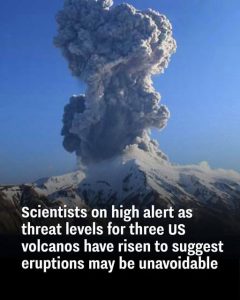Scientists and emergency management officials are paying particular attention to three U.S. volcanoes that are currently exhibiting increasing seismic activity: Hawaii’s Kilauea, Alaska’s Great Sitkin, and Mount Spurr. These events demonstrate how unstable volcanic systems are and how crucial early monitoring and community readiness are.
The situation at Great Sitkin has progressed to “Watch” status, meaning that there is a chance of an eruption and that the volcano is displaying high levels of disturbance. This designation indicates that magma is moving beneath the surface and comes after a string of minor earthquakes and visible lava emissions.

Seismic activity at Mount Spurr, also in Alaska, has increased dramatically, with a notable rise in the weekly number of reported earthquakes. Given the unpredictability of volcanic behavior, scientists believe there is a 50/50 chance of an eruption at Mount Spurr. Even if there hasn’t been an eruption yet, the increasing frequency of earthquakes is a certain indication that the volcano’s magma system is getting more active.
One of the world’s most active volcanoes, Kilauea, erupted once more in February 2025, launching lava fountains about 300 feet into the air. Even though the eruption has already stopped, the volcano is still a possible concern due to ongoing activity and high seismic readings. Continuous monitoring and readiness are essential because Kilauea’s previous eruptions have seriously damaged neighboring villages.
According to experts, the increasing magma levels beneath these volcanoes increase the likelihood of an eruption, which might result in hazardous outcomes like ashfall, lava flows, and the emission of poisonous volcanic gasses.
Residents, infrastructure, and air quality are all directly threatened by these risks, especially if the volcanoes erupt suddenly. In response, authorities are asking localities close to these volcanoes to check evacuation routes and backup plans, keep emergency supplies on hand, and stay informed through official updates.
Scientists are keeping an eye on the issue using a variety of cutting-edge instruments, such as gas monitors to measure emissions that indicate magma movement, satellite imaging to track surface changes, and seismic sensors to detect earthquakes. Additionally important are historical eruption records, which aid volcanologists in identifying trends and enhancing their capacity to predict future occurrences.
Authorities warn that even though no evacuations have been required as of yet, things might quickly change, particularly if earthquake activity keeps increasing. Being prepared is crucial to lowering the hazards connected with volcanic eruptions, as highlighted by the current phase of increased monitoring and community outreach.
